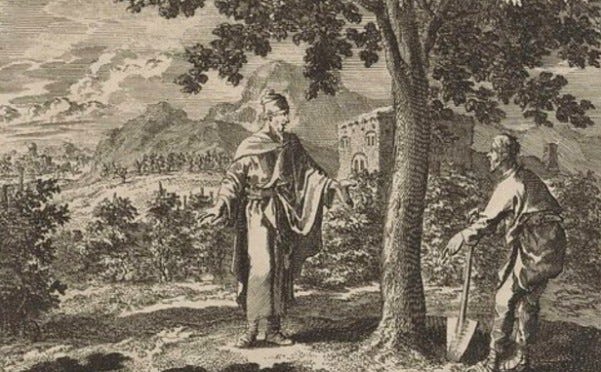Introduction
The Third Sunday of Lent marks the beginning of the Scrutinies, a series of three rituals that focus those who are preparing to be received into the Church at Easter. These remaining weeks of Lent are intended to be a time of interior reflection for those who are seeking entry into the Church, the Body of Christ. During this time, their desire for salvation leads to the purification and enlightenment that comes from true repentance.
They are reminded of the mission of Jesus, which is to encourage them to turn away from sin and to believe the Good News. And while the First Scrutiny ritual makes reference to the Gospel for the Third Sunday of Lent, Year A, which is the account of the encounter the Samaritan woman has with Jesus at Jacob’s well outside Sichar (John 4:5-41), the Gospel reading below is also relevant and will help them to prepare for their participation in the Easter Vigil Mass.
The procession from darkness to light will remind them of their own journey of faith, just as it does for everyone else present at that Mass to celebrate the Resurrection of Christ and the hope of their own resurrection. May you find this very same journey echoed in the Gospel that prompts this Enquiry.
The Third Sunday of Lent marks the beginning of the Scrutinies, a series of three rituals that focus those who are preparing to be received into the Church.
The Gospel
Some people arrived and told Jesus about the Galileans whose blood Pilate had mingled with that of their sacrifices. At this he said to them, ‘Do you suppose these Galileans who suffered like that were greater sinners than any other Galileans? They were not, I tell you. No; but unless you repent you will all perish as they did. Or those eighteen on whom the tower at Siloam fell and killed them? Do you suppose that they were more guilty than all the other people living in Jerusalem? They were not, I tell you. No; but unless you repent you will all perish as they did.’
He told this parable: ‘A man had a fig tree planted in his vineyard and he came looking for fruit on it but found none. He said to the man who looked after the vineyard, “Look here, for three years now I have been coming to look for fruit on this fig tree and finding none. Cut it down; why should it be taking up the ground?” “Sir,” the man replied “leave it one more year and give me time to dig round it and manure it: it may bear fruit next year; if not, then you can cut it down.”’ (Luke 13:1-9).
The Enquiry
See
What is the situation faced by Jesus in this part of Luke’s Gospel? Look at the people involved in this Gospel scene. Where would you put yourself: with the people, or with Jesus?
Why does Jesus counter the beliefs implied in the concern shown concern expressed by the people who came to him?
What does Jesus offer as the solution to the view of the world revealed in their concern?
Judge
What do you think about the concern theview of the world of the people who camehave, his response and the parable he shares with them?
Ideally, what ought to characterize people’s image of God?
What have you found in Jesus’ message that affirms your faith? What does he say that challenges you to seek to change your relationship with God?
Act
What do you want to change in yourself and in the world so that more will come to recognise, accept and celebrate the love of God for them and for all creation?
What action can you carry out this week that will contribute to the change you would like to see in the world?
Who can you involve in your action, when, how often and how?
Image source: Jan Luyken, print maker (1649-1712) (Creator), Rijks Museum, Amsterdam: Parable of the barren fig tree, lookandlearn.com, CCO 1.0


